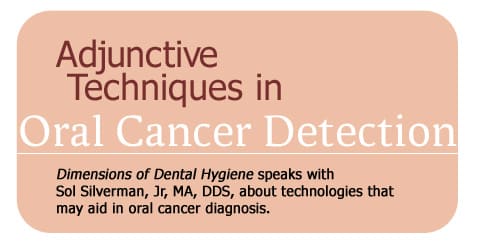
Adjunctive Techniques in Oral Cancer Detection
Dimensions of Dental Hygiene speaks with Sol Silverman, Jr, MA, DDS, about technologies that may aid in oral cancer diagnosis.
Q. How can adjunctive techniques help in the diagnosis of oral cancer?
A. Every dental professional should perform an oral cancer examination periodically. Sometimes, a low degree of suspicion or scheduling problems lead to a delay in a diagnostic procedure that may very well affect the prognosis and extent of treatment. This is when adjunctive techniques are helpful in identifying an urgency in establishing a definitive diagnosis. Currently three techniques are available: the use of a light source (chemiluminescence), toluidine blue staining, and brush biopsy. These techniques are adjuncts—not substitutes for biopsy. They accelerate the biopsy and the establishment of a definitive diagnosis.
Q. How do the light technologies work?
A. Two products use a light source to improve the identification of suspicious lesions: ViziLite* and the VELscope™ Mucosal Examination System**. ViziLite has been available for approximately 2 years. It is an oral lesion identification and marking system that contains a chemiluminescent light source to enhance the visibility of lesions. Vizilite Plus also contains a blue phenothiazine dye to mark the noted lesions. ViziLite refracts abnormalities within the tissue so they appear as a white change on the surface. The ViziLite kit contains a small bottle of vinegar (1% raspberry-flavored acetic acid), which prepares the tissue. It is just a 30 second application or mouthrinse. The light source is in a tube, which when bent, activates the light for the oral inspection. The purpose is to enhance what the clinician is looking at clinically with the hope that this will help not only find abnormalities, but also accelerate further the examination of these lesions.
A new product on the market, the VELscope, is a hand-held device that uses the direct visualization of tissue fluorescence and the changes in fluorescence that result when abnormal tissue is present. The handpiece emits a blue light into the oral cavity that stimulates the tissue, causing it to fluoresce. The handpiece’s optical filters allow the clinician to immediately view the different fluorescence responses of healthy vs abnormal oral tissue. The healthy tissue appears bright green while suspicious areas appear dark.
Q. Please describe how the toluidine blue works.
A. Pharmaceutical grade toluidine blue (1% tolonium chloride), which is supplied in the new product ViziLite Plus with TBlue630™*, is an aqueous solution that is applied to the tissue and then decolorized. The decolorization is done with reapplication of the acetic acid. If abnormal cells are present, the dye will stick. It’s almost like dropping ink on a blotter. If the cells are not dysplastic or malignant, usually the toluidine blue will be clear so a negative response appears. The accuracy exceeds 90%.1
Q. How does the Brush Biopsy aid in oral cancer detection?
A. The Oral Brush Biopsy*** has been used for approximately 10 years now. It is not truly a “biopsy” but rather a cytologic technique. The company uses the term biopsy because the brush is collecting cells, essentially representing the full thickness of the stratified squamous epithelium. With the brush, the clinician is obtaining hundreds of thousands of individual cells from an area that he or she finds suspicious, then transfers them to a slide and sends them off to the company to make the evaluation. All of this material comes in a kit that contains the brush, the slide, the fixative, a slide container, a form for patient and tissue information, and a mailer box.
Q. What effect do you think these techniques will have on oral cancer diagnosis rates?
A. Their purpose is to stimulate more offices to do oral cancer examinations. Logically, if more dental offices are performing oral cancer examinations, more precancerous (dysplasia) and malignant diagnoses will occur and hopefully at an earlier stage. When a deviation from normal is noted, these techniques can help in assessment as to whether the lesion needs to be followed closely, referred, or biopsied. Whenever a patient has a lesion or deviation from normal, it should be followed until it disappears. Anything that disappears is not dysplastic or cancer. If a lesion continues in spite of a negative adjunctive test, then of course, this patient should be referred or biopsied to establish a definitive diagnosis and management plan.
*Zila Pharmaceuticals Inc, Phoenix
**LED Dental Inc, White Rock, British Columbia
***OralCDX® Laboratories, Suffern, NY
REFERENCE
- Silverman S Jr, Migliorati C, Barbosa J. Toluidine blue staining in the detection of oral precancerous and malignant lesions. Oral Surg Oral Med Oral Pathol. 1984;57:379-382.
From Dimensions of Dental Hygiene. September 2006;4(9): 28.

